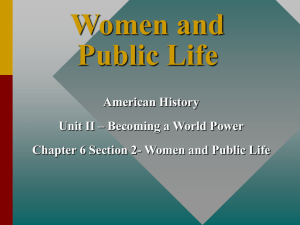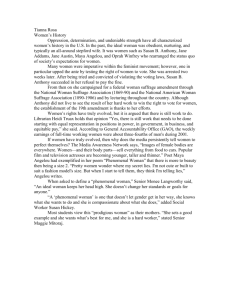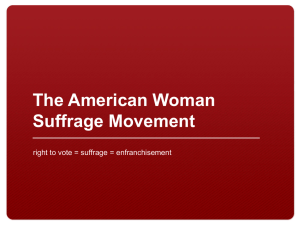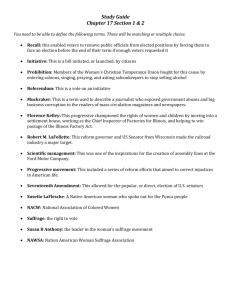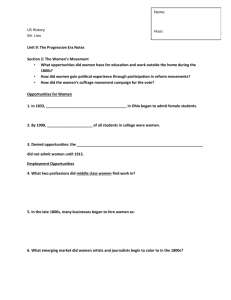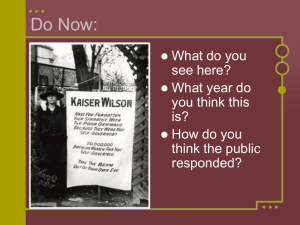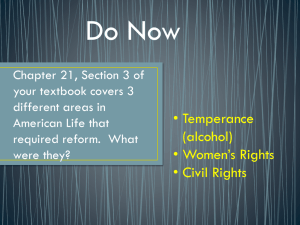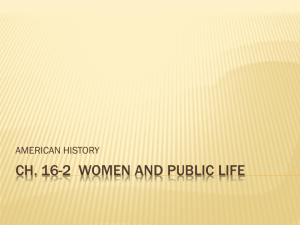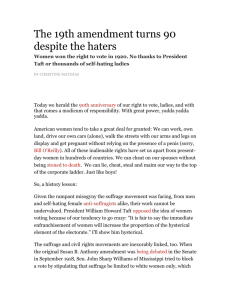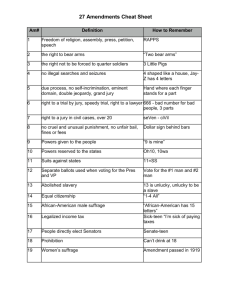Lesson 16-2 - Freeman Public Schools
advertisement
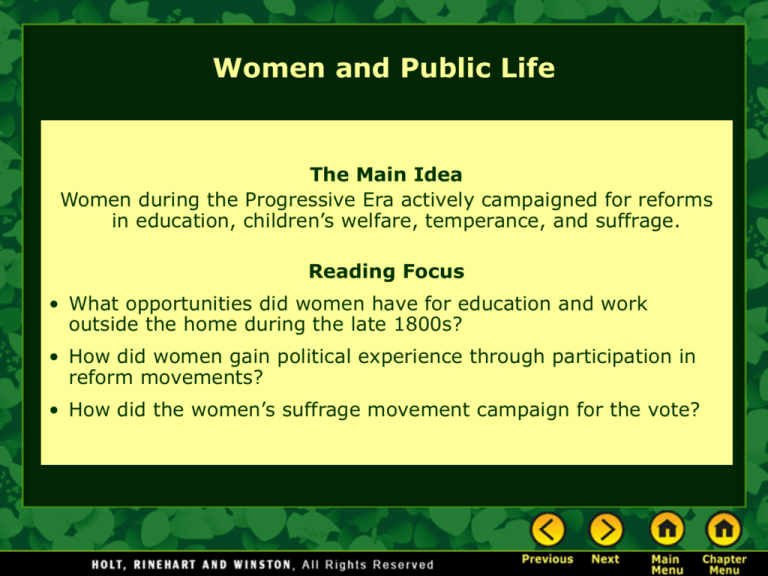
Women and Public Life The Main Idea Women during the Progressive Era actively campaigned for reforms in education, children’s welfare, temperance, and suffrage. Reading Focus • What opportunities did women have for education and work outside the home during the late 1800s? • How did women gain political experience through participation in reform movements? • How did the women’s suffrage movement campaign for the vote? Opportunities for Women • By the late 1800s, more educational opportunities arose as colleges, such as Oberlin College in Ohio, started enrolling women. • By 1870 about 20 percent of all college students were women, and by 1900 that number increased by a third. • Most of the women who attended college at this time were from the upper or middle classes and wanted to use their skills after graduation. • A few African American women, such as Alberta Virginia Scott and Otelia Cromwell, also attended colleges, but this was more rare. • However, many employment opportunities were still denied to women, as organizations such as the American Medical Association didn’t admit women until many years later. • Denied access to their professions, many women poured their knowledge and skills into the reform movement, gaining valuable political experience as they fought for change. Employment Opportunities • Job opportunities for educated middle-class women grew in the 1800s. • By the late 1800s, these opportunities in public life changed how women saw the world and the role they wanted in their communities. • Some new workplace opportunities for women included Women worked as Newspapers and Working-class and teachers and nurses in magazines began to uneducated women the traditional “caring hire more women took industry jobs professions,” but they as journalists and that paid less than also entered the artists, trying to men, as employers business world as cater to the new bookkeepers, typists, consumer group assumed women secretaries, and shop formed by educated clerks. women. were being supported by their fathers. Gaining Political Experience • As in earlier reform periods, women became the backbone of many of the Progressive Era reform movements. • Women learned how to organize, how to persuade people, and how to publicize their causes. • Reform also taught women that they had the power to improve life for themselves, their families, and their communities. • Some women campaigned for children’s rights, seeking to end child labor, improve children’s health, and promote education. – Lillian Wald, founder of the Henry Street Settlement in New York City, believed the federal government had a responsibility to tend to the well-being of children. – She campaigned tirelessly for the creation of a federal agency to meet that goal. – She was successful when the Federal Children’s Bureau opened in 1912. Prohibition • Progressive women also fought in the Prohibition movement, which called for a ban on making, selling, and distributing alcoholic beverages. • Reformers thought alcohol was responsible for crime, poverty, and violence. • Two major national organizations led the crusade against alcohol. – The Anti-Saloon League – The Women’s Christian Temperance Union (WCTU), headed by Frances Willard, which was a powerful force for both temperance and women’s rights • Evangelists like Billy Sunday and Carry Nation preached against alcohol, and Nation smashed up saloons with a hatchet while holding a Bible. Congress eventually proposed the Eighteenth Amendment in 1917, prohibiting the manufacture, sale, and distribution of alcohol. It was ratified in 1919, but was so unpopular that it was repealed in 1933. Civil Rights • African American women fought for many reforms, but with the added burden of discrimination, as many weren’t even welcome in certain reform groups. • African American women formed their own reform group, the National Association of Colored Women (NACW), in 1896. • Some of the most prominent African American women of the time joined, including Ida B. Wells-Barnett and Margaret Murray Washington, of the Tuskegee Institute Harriet Tubman, the famous Underground Railroad conductor • By 1914 the organization had more than 100,000 members campaigning against poverty, segregation, lynching, the Jim Crow laws, and eventually for temperance and women’s suffrage. Rise of the Women’s Suffrage Movement • After the Civil War, suffragists, who had supported abolition, called for granting women the vote but were told that they should wait. • Many were angered that the Fifteenth Amendment granted voting rights to African American men but not to women. • Women organized into two major suffragist groups: NWSA • National Woman Suffrage Association, founded by Elizabeth Cady Stanton and Susan B. Anthony. • Campaigned for a constitutional amendment letting women vote • Dealt with other women’s issues like labor reform and supported Victoria Woodhull, the first woman presidential candidate AWSA • American Woman Suffrage Association, with Henry Ward Beecher as President • Focused solely on winning the vote state-by-state and aligned itself with the Republican Party • Women began to see success in the West, as in 1869 the Wyoming Territory granted women the vote, followed by the Utah Territory a year later and five more western states not long after. Susan B. Anthony Tests the Law • Susan B. Anthony wrote pamphlets, made speeches, and testified before every Congress from 1869 to 1906 in support of women’s rights. • In 1872 she and three of her sisters registered to vote, voted for a congressional representative in Rochester, New York, and were arrested two weeks later. • Before her trial, Anthony spoke passionately about women’s voting rights, but the judge refused to let her testify on her own behalf and fined her $100. • Anthony didn’t pay the fine, hoping to be arrested so she could be tried through the courts, but the judge did not imprison her. • In 1873 the Supreme Court ruled that even though women were citizens, that did not automatically grant them voting rights, but that it was up to the states to grant or withhold that right. Anti-Suffrage Arguments Social • Some believed women were too frail to handle the turmoil of polling places on Election Day. • Some believed voting would interfere with a woman’s duties at home or destroy families. • Some claimed that women did not have the education or experience to be competent voters. • Others believed that most women did not want to vote, and that it was unfair for suffragists to force the vote on unwilling women. Economic • The liquor industry feared that giving the women the vote would lead to Prohibition. • As women became active in other reform movements, such as food and drug safety and child labor, business owners feared women would vote for regulations that would drive up costs. Religious • Churches and clergy members preached that marriage was a sacred bond and the entire family was represented by the husband’s vote. Two Suffrage Organizations Merge • In 1890 the National Woman Suffrage Association and the American Woman Suffrage Association merged to form the National American Woman Suffrage Association (NAWSA). • NAWSA operated under the leadership of Elizabeth Cady Stanton, and Susan B. Anthony was its President from 1892–1900. • Anthony died in 1906, and her final words were “Failure is impossible.” • Like Susan B. Anthony, most of the early suffragists did not live long enough to cast their ballots. • When women nationwide finally won the vote in 1920, only one signer of the Seneca Falls Declaration—the document written at the first Women’s Rights Convention in 1848—was still alive. – Her name was Charlotte Woodward, and she was a glove maker.
